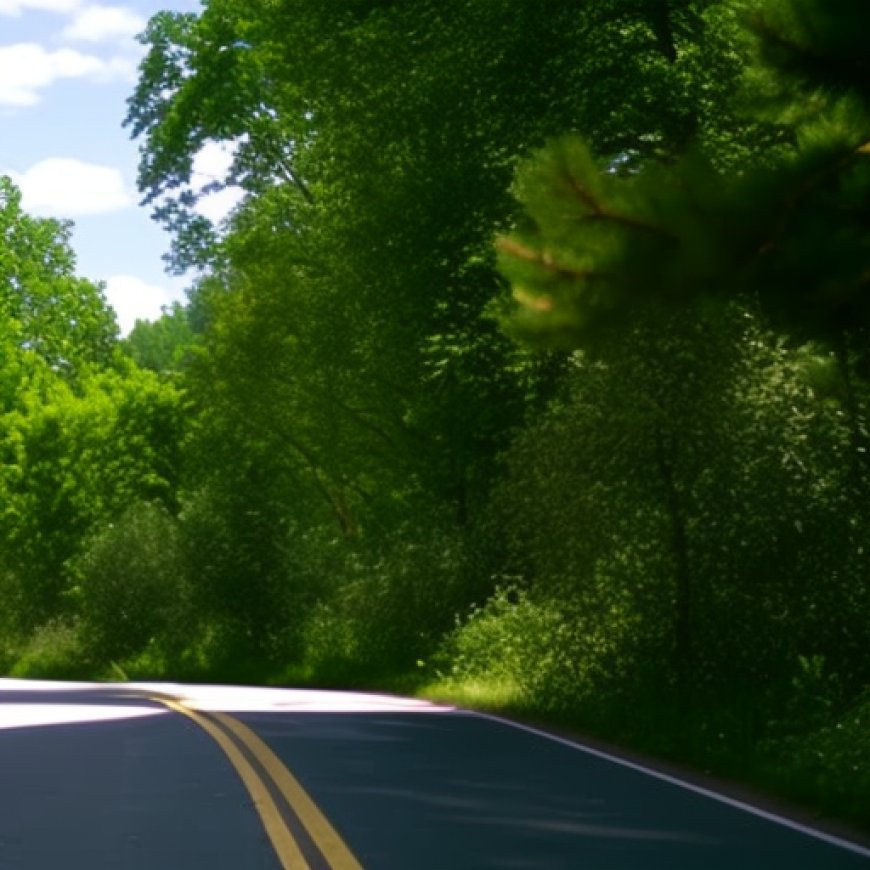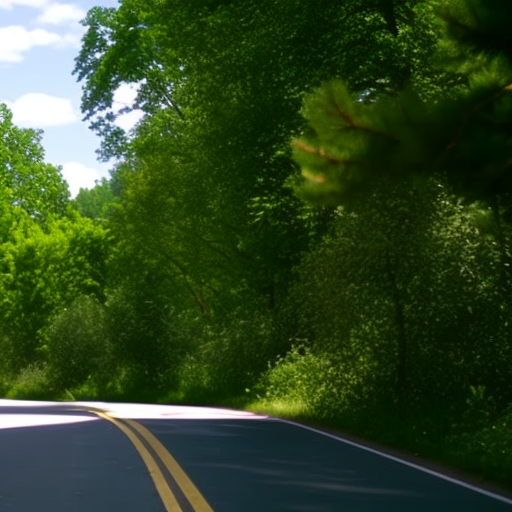Trees and bushes near highways improve air quality
Trees and bushes near highways improve air quality Earth.com


The power of trees
Anyone who’s endured rush-hour bumper-to-bumper traffic knows how unpleasant the air can get. Between fumes, dust, and all those exhaust pipes, it’s definitely not a nature lover’s paradise. But what if those trees and bushes lining our highways weren’t just there for decoration?
What if they were secretly cleaning the air you breathe? Well, a new study from Georgia State University says they just might be.
Trees near highways
We all know trees are vital for the environment. They turn carbon dioxide into oxygen and give us shade – essentials for the planet. However, scientists have uncovered another lesser-known benefit of roadside greenery, and it may have you looking at those leafy medians in a whole new light.
“Trees and bushes near roadways don’t solve the problem of air pollution caused by motor vehicles, but they can help reduce the severity of the problem,” said Roby Greenwald, lead researcher on the study.
- Soot: Those black, carbon-filled particles that turn your fingers grimy if you live in a polluted city.
- Ultrafine particles: Microscopic nasties invisible to the naked eye, but they can do serious damage to your respiratory system if you breathe them in over time.
The Georgia State study measured the air quality around busy Atlanta highways, comparing sites with plentiful trees to those without.
Impressively, they found a 37% reduction in soot and a 7% reduction in ultrafine particles where trees and bushes were present.
The health connection
Air pollution is a bad news for our health. “A growing body of evidence has linked motor vehicle pollution to conditions such as asthma, chronic bronchitis, lung cancer, and heart attacks,” said Greenwald.
It’s especially worrying for the 45 million Americans living, working, or studying within a stone’s throw of a major highway. Children are particularly vulnerable, as their lungs are still developing.
So, anything that helps reduce their exposure, even a little, is a win for public health.
Not a miracle solution
While this is fantastic news, it’s important to be realistic. Trees aren’t going to magically make all our pollution problems go away. “Trees and bushes near roadways don’t solve the problem of air pollution caused by motor vehicles, but they can help reduce the severity of the problem,” said Greenwald.
Greenwald emphasizes that for a truly comprehensive approach, we need to tackle the root cause of the problem: our dependence on cars. This means making public transport more accessible and convenient, and investing in better cycling and pedestrian infrastructure.
Getting people out of their cars and onto bikes or buses is the ultimate way to improve air quality for everyone.
Planting trees alongside highways
So, the next time you’re stuck in traffic, give a little thanks to those unassuming trees along the road. They’re working hard to make your commute that tiny bit healthier. As Greenwald noted: “We should plant more trees along roadways because they provide benefits that go beyond aesthetics.”
This doesn’t excuse us from finding real ways to ditch our car dependency. However, sometimes progress happens in small steps, and every cleaner breath we take thanks to some strategically placed greenery is a step in the right direction.
The study is published in the journal PLOS ONE.
SDGs, Targets, and Indicators
| SDGs | Targets | Indicators |
|---|---|---|
| SDG 3: Good Health and Well-being | 3.9 By 2030, substantially reduce the number of deaths and illnesses from hazardous chemicals and air, water, and soil pollution and contamination. | – Reduction in soot and ultrafine particles in the air near highways where trees and bushes are present. – Improvement in respiratory health outcomes for individuals living near highways with trees and bushes. |
| SDG 11: Sustainable Cities and Communities | 11.6 By 2030, reduce the adverse per capita environmental impact of cities, including by paying special attention to air quality and municipal and other waste management. | – Reduction in air pollution particles, such as soot and ultrafine particles, near highways with trees and bushes. – Increase in the number of trees planted alongside highways. |
| SDG 13: Climate Action | 13.2 Integrate climate change measures into national policies, strategies, and planning. | – Increase in the number of trees planted alongside highways as a climate change mitigation strategy. – Reduction in carbon dioxide emissions near highways with trees and bushes. |
1. Which SDGs are addressed or connected to the issues highlighted in the article?
SDG 3: Good Health and Well-being
The article discusses the impact of air pollution on health, particularly respiratory health. It highlights the link between motor vehicle pollution and conditions such as asthma, chronic bronchitis, lung cancer, and heart attacks. The presence of trees and bushes near highways is shown to reduce the severity of air pollution, thereby contributing to good health and well-being.
SDG 11: Sustainable Cities and Communities
The article emphasizes the importance of trees and bushes alongside highways as a means to reduce air pollution. This aligns with SDG 11, which aims to create sustainable cities and communities by reducing the adverse environmental impact of cities, including air quality.
SDG 13: Climate Action
The article mentions the role of trees in converting carbon dioxide into oxygen, highlighting their contribution to climate change mitigation. Planting trees alongside highways can be seen as a climate action measure to reduce carbon dioxide emissions.
2. What specific targets under those SDGs can be identified based on the article’s content?
Target 3.9: By 2030, substantially reduce the number of deaths and illnesses from hazardous chemicals and air, water, and soil pollution and contamination.
The article’s content supports this target by demonstrating how trees and bushes near highways can help reduce air pollution particles, such as soot and ultrafine particles, which are hazardous to health.
Target 11.6: By 2030, reduce the adverse per capita environmental impact of cities, including by paying special attention to air quality and municipal and other waste management.
The article’s content aligns with this target by highlighting the role of trees and bushes alongside highways in improving air quality and reducing the adverse environmental impact of cities.
Target 13.2: Integrate climate change measures into national policies, strategies, and planning.
The article indirectly supports this target by promoting the planting of trees alongside highways as a climate change mitigation strategy. Trees contribute to reducing carbon dioxide emissions and can be integrated into national policies and planning.
3. Are there any indicators mentioned or implied in the article that can be used to measure progress towards the identified targets?
The article mentions two indicators that can be used to measure progress towards the identified targets:
- Reduction in soot and ultrafine particles in the air near highways where trees and bushes are present: This indicator can be used to assess the effectiveness of trees and bushes in reducing air pollution.
- Improvement in respiratory health outcomes for individuals living near highways with trees and bushes: This indicator can be used to measure the impact of trees and bushes on reducing the number of deaths and illnesses related to air pollution.
- Increase in the number of trees planted alongside highways: This indicator can be used to track progress in implementing climate change measures and improving air quality in cities.
- Reduction in carbon dioxide emissions near highways with trees and bushes: This indicator can be used to assess the contribution of trees and bushes to climate change mitigation.
SDGs, Targets, and Indicators
| SDGs | Targets | Indicators |
|---|---|---|
| SDG 3: Good Health and Well-being | 3.9 By 2030, substantially reduce the number of deaths and illnesses from hazardous chemicals and air, water, and soil pollution and contamination. | – Reduction in soot and ultrafine particles in the air near highways where trees and bushes are present. – Improvement in respiratory health outcomes for individuals living near highways with trees and bushes. |
| SDG 11: Sustainable Cities and Communities | 11.6 By 2030, reduce the adverse per capita environmental impact of cities, including by paying special attention to air quality and municipal and other waste management. | – Reduction in air pollution particles, such as soot and ultrafine particles, near highways with trees and bushes. – Increase in the number of trees planted alongside highways. |
| SDG 13: Climate Action | 13.2 Integrate climate change measures into national policies, strategies, and planning. | – Increase in the number of trees planted alongside highways as a climate change mitigation strategy. – Reduction in carbon dioxide emissions near highways with trees and bushes. |
Behold! This splendid article springs forth from the wellspring of knowledge, shaped by a wondrous proprietary AI technology that delved into a vast ocean of data, illuminating the path towards the Sustainable Development Goals. Remember that all rights are reserved by SDG Investors LLC, empowering us to champion progress together.
Source: earth.com

Join us, as fellow seekers of change, on a transformative journey at https://sdgtalks.ai/welcome, where you can become a member and actively contribute to shaping a brighter future.







